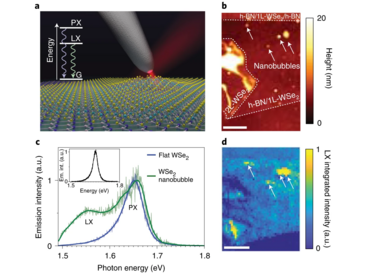Nature Nanotechnology (2020) 15, 854-860
https://doi.org/10.1038/s41565-020-0730-5
In monolayer transition-metal dichalcogenides, localized strain can be used to design nanoarrays of single photon sources. Despite strong empirical correlation, the nanoscale interplay between excitons and local crystalline structure that gives rise to these quantum emitters is poorly understood. Here, we combine room-temperature nano-optical imaging and spectroscopic analysis of excitons in nanobubbles of monolayer WSe2 with atomistic models to study how strain induces nanoscale confinement potentials and localized exciton states. The imaging of nanobubbles in monolayers with low defect concentrations reveals localized excitons on length scales of around 10 nm at multiple sites around the periphery of individual nanobubbles, in stark contrast to predictions of continuum models of strain. These results agree with theoretical confinement potentials atomistically derived from the measured topographies of nanobubbles. Our results provide experimental and theoretical insights into strain-induced exciton localization on length scales commensurate with exciton size, realizing key nanoscale structure–property information on quantum emitters in monolayer WSe2.


